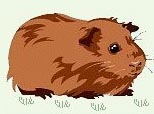summer 2016 projects
|
Olivia Sims joined the Dearolf lab as a volunteer in the spring of 2015. Last summer, with funding from the Hendrix College Odyssey Program, she studied the neonatal guinea pig rectus thoracis, an accessory inspiratory muscle. She determined the percentages and diameters of type IIA and IIX fibers present in this muscle, as well as its myosin heavy chain expression pattern and compared these characteristics to those of fetal muscles (59-days gestation) exposed to multi-course prenatal steroids and control fetal muscles (Schroeder et al., 2010; Brown et al., 2013) to determine if exposure to the steroids accelerated the development of the rectus thoracis muscle. And, she presented the results of her study at the 2016 Society for Integrative and Comparative Biology (SICB) meeting in Portland, OR. | |
 |
This summer, Olivia is going to determine if guinea pigs choose to swim. Currently, it is known that guinea pigs can swim, but to date, no studies have investigated whether or not they would choose to swim. To determine if they exhibit this behavior, Olivia will use a y-maze in which the guinea pigs will choose between a dry path and a path with water deep enough to swim. Both paths will lead to a reward of Timothy Hay. If females that choose to swim can be identified, they will be bred and allowed to swim during their pregnancies in order to determine how much exercise is necessary in order to induce positive changes in the muscle physiology of their offspring.
|
|
Brandon Cathey started working in the Dearolf lab as a volunteer in the spring of 2016. This summer, he is studying the vocal muscles of killer whales and long-beaked common dolphins. To characterize these muscles , Brandon is determining their fiber-type profiles (percent fast-twitch fibers), fiber sizes (fast- and slow-twitch), myosin heavy chain expression, and glycolytic enzyme activities. To understand the function of the killer whale and common dolphin vocal muscles, he will compare their physiological characteristics to those of bottlenose dolphins, studied by Sarah McHugh, and harbor porpoises, studied by Megan Murphy. And, all of these projects would not have been possible without our collaborators in Santa Cruz, California, Drs. Nicole Thometz, Robin Dunkin, and Terrie Williams, and Drs. Dawn Noren and Marla Holt in Seattle, Washington. |
  |
 Return to research page
Return to research page  Return to home page
Return to home page